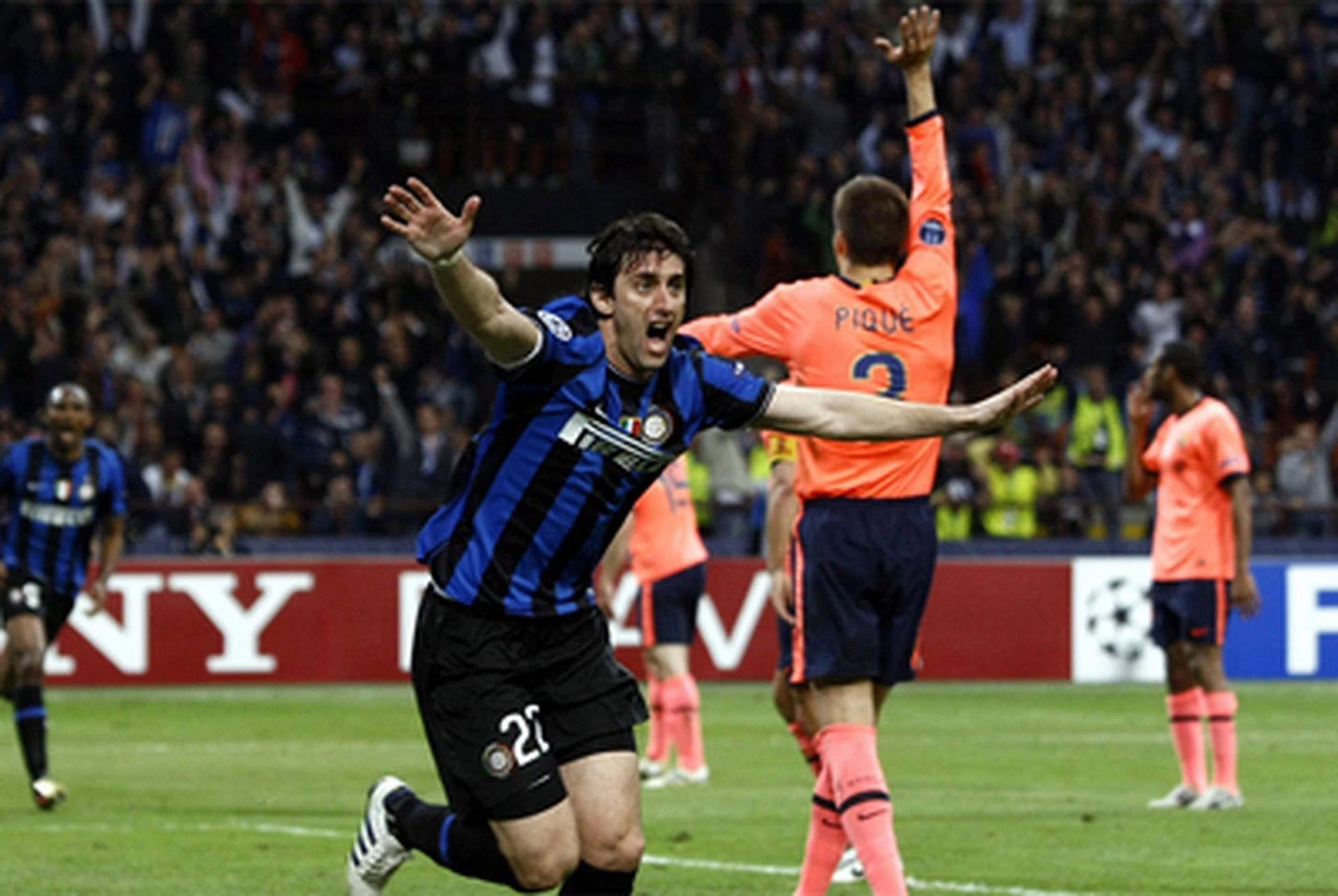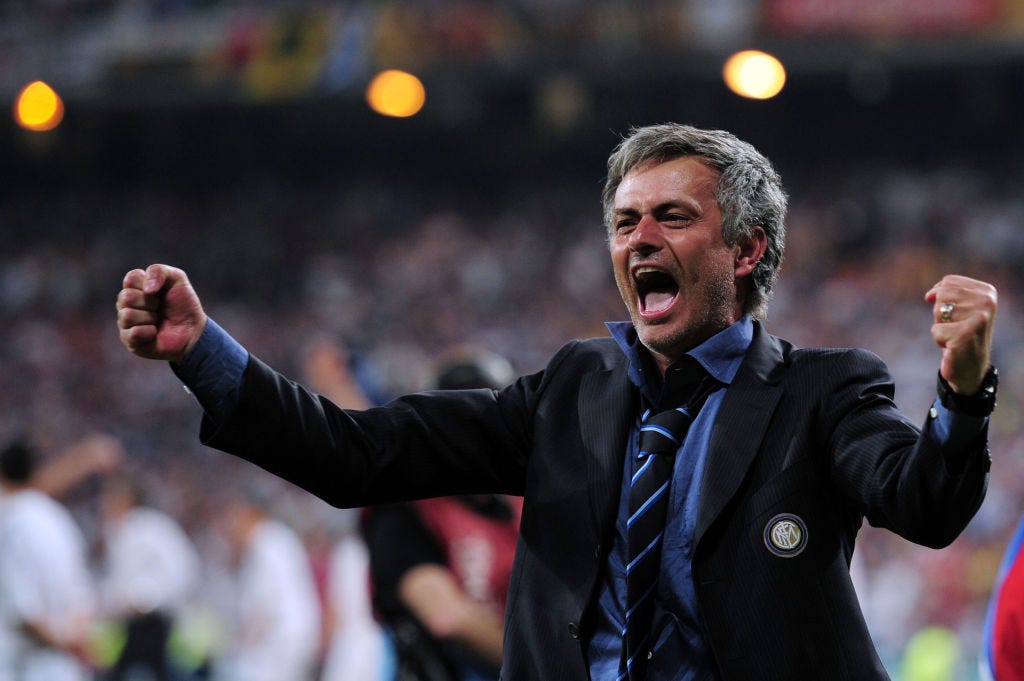Inter Milan 3-1 Barcelona (2010) Analysis
How Mourinho's men dominated the game despite having less than 40% of the ball.
This UCL tie needs no introduction - Pep’s Barcelona vs Mourinho’s treble winners-to-be. Mourinho has been quoted as saying that though people remember the famous 1-0 loss at the Camp Nou, where Inter defended from the first to the last minute, he felt that the 3-1 at the San Siro was the game where Inter truly outplayed Barça. This is what prompted my analysis of this legacy-defining game.
Inter Lineup
Inter’s lineup gave a clear indication of their aim - to block Barça’s central progression and chance creation. Mourinho opted to sacrifice offensive width for defensive compactness. In terms of the profiles in the XI - there is a common theme of aggression, hard work, and running power (not looking to be reductive of the squad, but these are traits shared by all the players in Inter’s lineup).
Out of Possession Approach
Barça were always going to dominate the ball, and Inter were happy to let them do so as long as the possession wasn’t penetrative or in Inter’s third of the pitch. Inter’s shape for the majority of the match was a mid-block - varying between a 4-4-2 (Sneijder pushing up with Milito, with Eto’o dropping as the right midfielder of the midfield 4) and an occasional 4-5-1 (Sneijder dropping into the midfield 5, leaving Milito as the lone forward).
While Messi was obviously Barça’s main threat, the progression into the final third almost always came from Busquets or Xavi - part of Inter’s out of possession approach was using their front two of Sneijder and Milito to screen Barça’s pivot players, preventing direct passes into their feet.
Any time Barça attempted to play into their forward line centrally, the receiver would have an Inter player tight on their back - forcing the receiver to take a poor touch or make a backwards pass - never letting them turn or giving them time on the ball to pick their head up and play.
Using their compact shape, Inter looked to funnel Barça’s play down the wings - they were not overly quick to close Barça’s wide players down, especially as they entered the final third - almost inviting early crosses into the Inter box. Inter had the qualitative superiority over Barça in these areas - Samuel and Lucio doubled up on Ibrahimović, Zanetti stayed tight to Messi, and Maicon didn’t give Pedro any space. Inter were generally comfortable dealing with the crossing threat provided by Barça, from Dani Alves especially.
Inter were noticeably quick to get back on defensive transitions - they were wary to not push up more than necessary - always leaving a base of 4 players at the back - either a 3+1, 4+1, or even a 4+2. Though Barça were known for their play through settled defences, they knew how to exploit space - Inter were conscious of it and countered effectively.
In Possession Approach
One statistic from this match will tell you everything about Inter’s in possession approach - they finished the game with 9 offsides called against them. Mourinho knew his men could hurt Barça through their attacking transitions - almost every time Inter won the ball back, the ball instantly went in the direction of Milito or Eto’o, varying between balls in behind and to feet. The movement from the strikers was automatic.
Both players were supported by deep runners - Maicon especially, but Pandev and Sneijder would constantly look to go beyond Barça’s last line as well. Inter were looking to release their outlets as quick and early as possible - not giving Barça players the time to sprint 30+ yards back into their own half, while also relieving the Inter back line of pressure, allowing them to push up. The constant sprinting backwards throughout the course of the match would also wear down Piqué and Puyol.
In-game Adaptations
Barça Players Dropping to Receive
In the early stages of the game, Barça’s danger players - Messi, Xavi, and Busquets, were not seeing enough of the ball to have an influence on the game - Messi was being man-marked everywhere he went and the pivot players were sandwiched between Inter’s front 2 and Inter’s midfield pivot. Xavi and Busquets began to drop into the back line so they could receive facing the game, with no pressure on their back. Messi began to drop outside of the Inter block, much for the same reason.
As a result though, Barça’s presence in the middle became very thin - with the players vital to their central progression not able to take up dangerous positions, the opportunity to move the ball through the middle decreased. Barça began to force the ball into Ibrahimović from deep - since he was marked by both Inter centre-backs, it was too much to ask from the Swede. Messi looked to break through the block from the outside with his dribbling, but Zanetti, Motta, and Cambiasso were up to the task on the day and were able to pressure him off the ball consistently.
Barça’s Full-backs
Through their attacking transitions, Inter kept targeting the space on the outside of Barça’s centre-backs - space that would be occupied by a full-back that hadn’t pushed up. Most of Inter’s attacking transitions came from passes played by a full-back or centre-mid into Milito/Eto’o, following an in-to-out run from the strikers. As a result, both Dani Alves and Maxwell became more conservative with their forward runs. Piqué and Puyol were constantly sprinting back towards their own goal without cover - had this continued throughout the match, it is likely Inter would’ve been able to tire them out and capitalize later on in the game.
This was an important tweak from Barça because their full-backs would’ve been key to stage any form of dangerous attack - in fact, Barça’s only goal came from a situation where they had a 3v3 on the wing and Maxwell was able to go beyond the Inter back line and provide a cutback.
Separation of Barça’s XI
Both of these tactical adaptations essentially split Barça’s XI into two separate entities - the front 4: front 3 + Keita and the back 6: Xavi-Busquets + back 4. The midfielders dropped to receive, the full-backs dropped to stifle potential transitions, and the forward-thinking players stayed up the pitch, looking to pin Inter’s back 4. There was enough space between the lines for a player to receive - but the only players that could drop in were the front 4, who were aggressively followed by Inter’s back 4. Busquets and Xavi were too deep to make any movements to receive between the lines.
With no central presence and large vertical distances between the two units, Barça’s possession turned into harmless sideways passing - still mentally fatiguing for Inter to chase the ball, but just as equally frustrating for a Barça team void of ideas. Messi and Pedro often received the ball completely surrounded by Inter players - multiple scenarios with 3v1s, 4v1s, 5v2s, etc. To create chances from these situations would require moments of individual brilliance which were not there on the day.
Barça Central Overloads
After Inter’s 2nd goal, Pedro started to move infield to give Barça an extra player in the middle of the pitch. This led to some rotations between Messi and Pedro - Messi occupied the space Pedro vacated. This movement from Pedro immediately occupied one of either Motta or Cambiasso, which gave either Xavi or Busquets space to push up, as one of the Inter CMs was essentially pinned by Pedro. With Messi moving central as well, Barça created a clear overload in the middle. This central advantage did not last long - Pandev recognized the overload and tucked into the middle of the pitch from his left-halfspace defensive position, to man-mark either Pedro or Messi. This actually gave Barça even more freedom to push up a fullback - however, they still did not look to exploit Inter in this manner.
Barça also looked to push one of Busquets or Xavi forward, between the lines, leaving the other as a lone pivot - the idea here was to bait one of the Inter CMs to jump onto the lone pivot, which would leave the static CM underloaded against players like Busquets, Messi, and Pedro. Mourinho reacted quickly and subbed on Stanković for Pandev and asked Sneijder to drop back as a left-sided midfielder. Inter essentially became a 4-5-1 out of possession and were able to stifle Barça.
No prizes for guessing what Mourinho is telling Stanković to do in the clip above.
Final 30 Minutes
Those proved to be the last meaningful in-game adjustments - roughly 5 minutes after Stanković was subbed on, Inter scored the game’s final goal, their third. This allowed them to sit back in a lower block than they had been all game - inviting the pressure from Barça, but dealing with it quite comfortably.
Final Thoughts
It is important to note that Barça’s more reliable players did not seem to be ‘on it’ on the day - there were many simple technical mistakes from players like Xavi, Busquets, and Pedro. Messi wasn’t great, but part of that was down to having a man shadow him for 90 minutes. Inter made the Barça players feel uncomfortable - they took them by surprise and never let them settle, even when Barça were 1-0 up. Inter hounded Barça out of the middle of the pitch and Barça had no solution.
This leads to an interesting conclusion that can be drawn from this match - people often say that the team that dominates the game is the one that has the ball and pins their opponent back during the match. Inter, however, did not look uncomfortable at any point during the game - Mourinho’s team showed us that the team that ‘dominates’ is the one that can impose and execute their game plan better than the other.
Thank you for reading!








